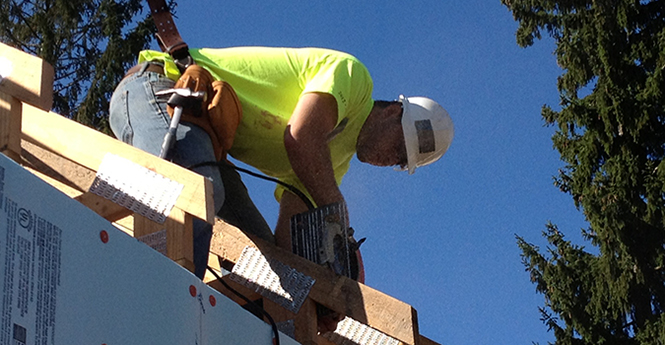Kent State students design houses with Habitat for Humanity
September 28, 2013
Kent State architecture and construction management students have partnered with Habitat for Humanity to build two sustainable houses in Columbiana County.
Construction on the house in Leetonia started two months ago, and plans are in place to build the second house in Salem, where Kent has a regional campus. The houses are supposed to be finished Oct. 27.
Starting in 2012, assistant professor Joseph Ferut, instructor Jack Hawk, instructor Lee Phillips and lecturer George Bigham “initiated a studio project to design a sustainable home for Habitat for Humanity,” Max Wagner, College of Architecture and Environmental Design graduate student, wrote in an email.
“After meeting with George (Bigham) and Joe Ferut from the School of Architecture, the partnership quickly developed,” Barbara Loudon, executive director of Habitat for Humanity of Northern Columbiana County , or HFHNCC, wrote in an email.
Fourth-year architecture students designed more than 30 houses for the project, said Bigham, lecturer in the College of Applied Engineering, Sustainability and Technology. Eight of those students were in an independent study to develop three of the chosen designs. Ferut said three students continued to volunteer through the construction.
“This is the first time we have partnered with them on the design, estimating and construction phase,” Bigham said.
Two designs were chosen to build houses in Leetonia and Salem, both of which are less than 1,200 square feet.
“I provided the working drawings and schematic design of this house that is currently under construction in Columbiana County,” Wagner said.
“We wanted the students to design a house that a real low income family could call home,” Loudon said. “HFHNCC was interested in new design options for our homes as well as new energy efficient building techniques to save our homeowners money.”
The homes are designed to consume less energy, using sustainable and low environmental impact materials.
“Sustainability drove the whole project,” Bigham said. “The cost of operation would approximately be half of what a normal habitat house would be. The final estimate at the end of the semester is around $100,000.”
“The windows and overhangs have been designed to use the sun to heat the home in the winter and to avoid overheating from the sun in the summer,” Wagner said. “The most interesting thing is the sustainable designs and energy efficient technologies that are cost effective.”
Construction management student Aaron Mayweski said, “This will help them save money on their utility bills.”
Habitat for Humanity charges families no interest on their mortgage loan in return for the partner families to volunteer their time to help build a home for another family and then their own family, Loudon said.
The students were able to provide designs that were more appropriate for lots that were not flat, rectangular pieces of land. The traditional style of house was not going to be the best fit.
“From the beginning, our students have a real-life customer and they get to experience that real-life process,” Bigham said.
Wagner said he “learned a great deal about keeping a project within budget, working with clients and organizations to design and develop projects.”
The extra motivation and effort the students put into the project is because it is for a good cause, Bigham said.
“Our goal is that these houses we build and design can be used across the country,” Bigham said.
“We were truly overwhelmed by their thoughtful, innovative designs and the enthusiasm with which they presented their work,” Loudon said.
Carolyn Pippin is a news correspondent for the Daily Kent Stater. Contact her at [email protected].












